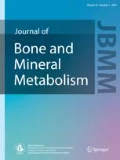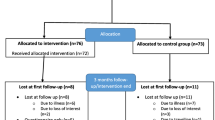Abstract
The purpose of this study was to investigate whether a 48-week multicomponent exercise program could improve the risk factors for fall and hip fracture. Fifty elderly women 65–70 years of age participated. These participants were divided into an exercise group (25 subjects) that attended an exercise program and a control group (25 subjects) that did not. The exercise program included stretching for 9 min, strength training for 10 min followed by 23 min of weight-bearing exercise at an intensity above 65%–75% of the maximal heart rate, and 18 min of balance and posture correction training. The program was conducted three times per week for 48 weeks. The 10-m maximal walk time, maximal step length, and eyes-open-one-legged-stand time in the exercise group improved significantly (P < 0.05). Concerning deoxypyridinoline, the exercise group achieved a significant improvement (P < 0.05) after the 48 weeks. Bone mineral density (BMD) of the femoral neck and trochanter in the exercise group was significantly increased after the exercise program; also body sway was significantly improved (P < 0.05). In conclusion, a multi-component exercise program with weight-bearing exercise at a moderate intensity and gait training may be effective in offsetting a decline in BMD and improving aggravation of bone resorption in this population. In addition, this program has a positive effect on postural stability and gait ability.
Similar content being viewed by others
References
American Geriatrics Society, British Geriatrics Society, and American Academy of Orthopedic Surgeons Panel on Falls Prevention (2001) Guideline for the prevention of falls in older persons. J Am Geriatr Soc 49:664–672
Clark AN (1968) Factors in fracture of the female femur: a clinical study of the environmental, physical, medical and preventative aspects of the injury. Gerontol Clin 10:257–270
Cummings SR, Kelsey JL, Nevitt MC, O’Dowd KJ (1985) Epidemiology of osteoporosis and osteoporotic fractures. Epidemiol Rev 7:178–208
Cummings SR, Black DM, Nevitt MC, Browner W, Cauley J, Ensrud K, Genant HK, Palermo L, Scott J, Vogt TM (1993) Bone density at various sites for prediction of hip fractures. The Study of Osteoporotic Fractures Research Group. Lancet 341:72–75
Gehlsen GM, Whaley MH (1990) Falls in the elderly: part II, balance, strength, and flexibility. Arch Phys Med Rehabil 71: 739–741
Luukinen H, Koski K, Laippala P, Kivela SL (1995) Predictors for recurrent falls among the home dwelling elderly. Scand J Prim Health Care 13:294–299
Cheng PT, Liaw MY, Wong MK, Tang FT, Lee MY, Lin PS (1998) The sit to-stand movement in stroke patients and its correlation with falling. Arch Phys Med Rehabil 79:1043–1046
Tinetti ME (1994) Prevention of falls and fall injuries in elderly persons: a research agenda. Prev Med 23:756–762
Steadman J, Donaldson N, Kalra L (2003) A randomized controlled trial of an enhanced balance training program to improve mobility and reduce falls in elderly patients. J Am Geriatr Soc 51:847–852
Lord SR, Lloyd DG, Nirui M, Raymond J, Williams P, Stewart RA (1996) The effect of exercise on gait patterns in older women: a randomized controlled trial. J Gerontol Med Sci 51A:M64–M70
Mutoh Y, Kuroyanagi R, Ueno K, Ohta M (2002) Fall Prevention Class (2nd edn.) — medical approach on fall prevention (in Japanese). Japan Medical Journal, Tokyo
Greenspan SL, Myers ER, Maitland LA, Kido TH, Krasnow MB, Hayes WC (1994) Trochanteric bone mineral density is associated with type of hip fracture in the elderly. J Bone Miner Res 9: 1889–1894
Caplan GA, Ward JA, Lord SR (1993) The benefits of exercise in postmenopausal women. Aust J Public Health 17:23–26
Kohrt WM, Snead DB, Slatopolsky E, Birge SJ (1995) Additive effects of weight-bearing exercise and estrogen on bone mineral density in older women. J Bone Miner Res 10:1303–1311
Chein MY, Wu YT, Hsu RS, KAT GS (2000) Efficacy of 24 week-aerobic programs for osteopenic postmenopausal women. Calcif Tissue Int 67:443–448
Brooke-Wavell K, Athersmith L, Jones PRM, Masud T (1998) Brisk walking and postural stability: a cross-sectional study in postmenopausal women. Gerontology 44:288–292
Schwartz AV, Kelsey JL, Sidney S, Grisso JA (1998) Characteristics of falls and risk of hip fracture in elderly men. Osteoporos Int 8:240–246
American College of Sports Medicine (1995) Position stand on osteoporosis and exercise. Med Sci Sports Exerc 27:i–vii
Fiatarone M, O’Neill E, Ryan N (1994) Exercise training and nutritional supplementation for physical frailty in very elderly people. N Engl J Med 330:1769–1775
Silpila S, Multanen J, Kallinen M, Era P, Suominen H (1996) Effects of strength and endurance training on isometric muscle strength and walking speed in elderly women. Acta Physiol Scand 156: 457–464
Medell JL, Alexander NB (2000) A clinical measure of maximal and rapid stepping in older women. J Gerontol 8:M429–M433
Bohannon RW, Larkin PA, Cook AC, Gear J, Singer J (1984) Decrease in timed balance test scores with aging. Phys Ther 64:1067–1070
Author information
Authors and Affiliations
Corresponding author
About this article
Cite this article
Park, H., Kim, K.J., Komatsu, T. et al. Effect of combined exercise training on bone, body balance, and gait ability: a randomized controlled study in community-dwelling elderly women. J Bone Miner Metab 26, 254–259 (2008). https://doi.org/10.1007/s00774-007-0819-z
Received:
Accepted:
Published:
Issue Date:
DOI: https://doi.org/10.1007/s00774-007-0819-z




